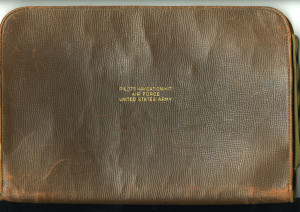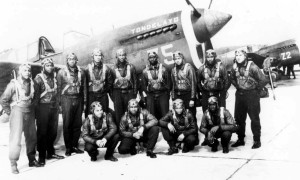When Crockett entered the military in 1940, he was assigned to the first black field artillery regiment, the 349th, in Fort Sill, Oklahoma. After being commended as a Model Soldier who exhibited “high technical skill” and “soldierly qualities of leadership, loyalty, and initiative,” Crockett transferred to the Tuskegee Institute in Alabama to join a segregated unit of African-American Army Air Corps cadets. As a cadet, he excelled as a pilot, finding that his skills in math helped him calculate the correct trajectory for his targets.
The group of African-American pilots and staff who trained at Tuskegee between the years of 1941 and 1946 are known as the “Tuskegee Airmen.” Upon entering World War II, they quickly earned a reputation for their few losses when protecting American bombers. The red paint on the tails of their aircraft led to the nickname the “Red Tails,” and their reputation caused the Germans to call them the “Black Birdmen.” In addition to the red paint, pilots often painted the name of their planes on the sides. Crockett’s was the “Daisy Mae” after his wife Daisy McMurray. Crockett flew 149 missions from 1944-1945 and received two Soldier’s Medals for rescuing pilots from burning aircraft, among countless other honors. The undeniable success of the Tuskegee Airmen in World War II was a key step in achieving military integration.
![Photographic image of [Fort Sill, Oklahoma. Members of the "A" battery of the 349th Field artillery regt.], circa 1941-1943. courtesy Library of Congress.](https://ualrexhibits.org/characters/files/2017/01/Tusegee-airman-waving-hats-Fort-Sill-349th-Crockett-2-300x238.jpg)



